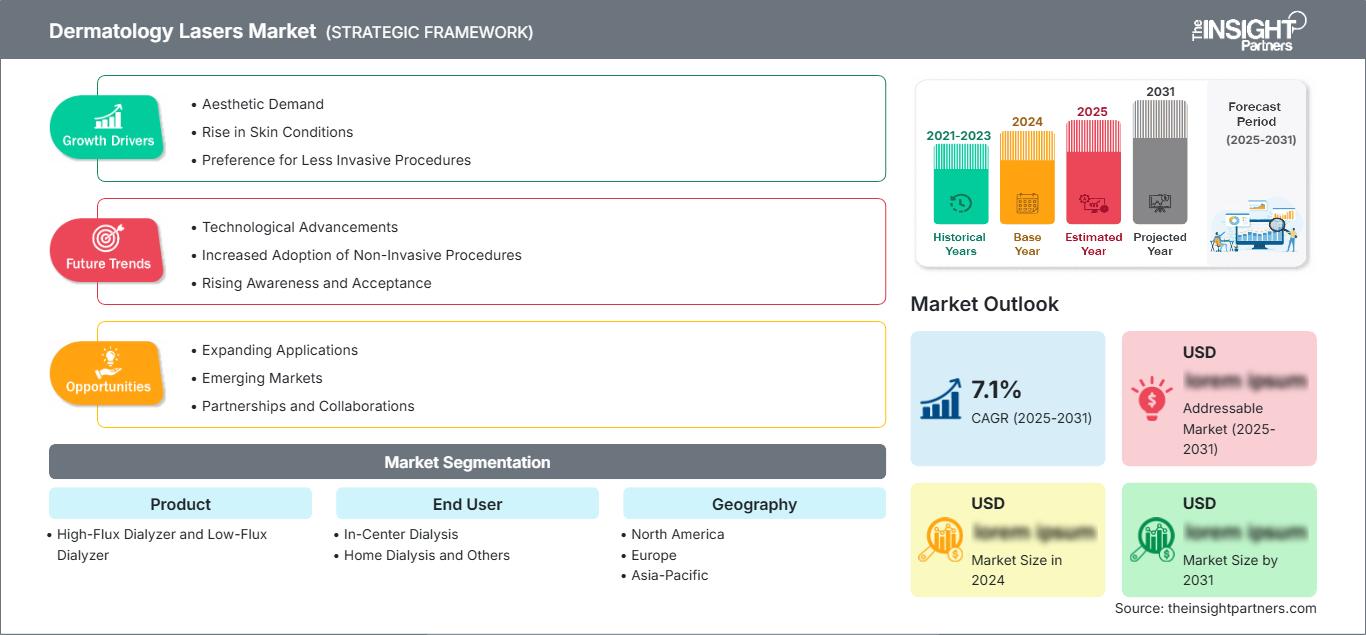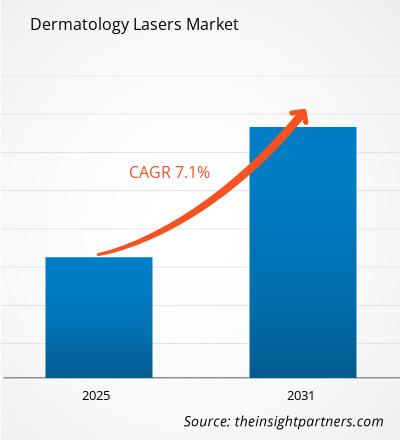Se espera que el mercado de láseres dermatológicos alcance los 5.850 millones de dólares estadounidenses para 2031. Se prevé que registre una tasa de crecimiento anual compuesta (TCAC) del 8,4 % entre 2025 y 2031.
El informe está segmentado por producto (dializador de alto flujo y dializador de bajo flujo) y usuario final (diálisis en centro, diálisis domiciliaria y otros). El análisis global se desglosa a nivel regional y por país. El informe ofrece el valor en USD de los análisis y segmentos mencionados.
Propósito del Informe
El informe "Mercado de Láseres Dermatológicos" de The Insight Partners busca describir el panorama actual y el crecimiento futuro, los principales factores impulsores, los desafíos y las oportunidades. Esto proporcionará información a diversas partes interesadas del negocio, como:
- Proveedores/fabricantes de tecnología: Para comprender la dinámica cambiante del mercado y conocer las oportunidades potenciales de crecimiento, lo que les permitirá tomar decisiones estratégicas informadas.
- Inversores: Realizar un análisis exhaustivo de tendencias respecto a la tasa de crecimiento del mercado, las proyecciones financieras del mercado y las oportunidades que existen en toda la cadena de valor.
- Órganos reguladores: Regular las políticas y las actividades policiales en el mercado con el objetivo de minimizar el abuso, preservar la confianza de los inversores y defender la integridad y estabilidad del mercado.
Segmentación del mercado de láseres dermatológicos
- Dializador de alto flujo y dializador de bajo flujo
Usuario final
- Diálisis en el centro
- Diálisis domiciliaria y otros
Obtendrá personalización en cualquier informe, sin cargo, incluidas partes de este informe o análisis a nivel de país, paquete de datos de Excel, así como también grandes ofertas y descuentos para empresas emergentes y universidades.
Mercado de láseres dermatológicos: perspectivas estratégicas

-
Obtenga las principales tendencias clave del mercado de este informe.Esta muestra GRATUITA incluirá análisis de datos, desde tendencias del mercado hasta estimaciones y pronósticos.
Factores que impulsan el crecimiento del mercado de láseres dermatológicos
- Demanda estética: El deseo de mejorar la apariencia es uno de los principales impulsores del mercado. De hecho, esto está impulsando la creciente popularidad de procedimientos cosméticos como los tratamientos láser, que son menos invasivos.
- Aumento de las afecciones cutáneas: La carga de diversas afecciones cutáneas crónicas, como el acné, la rosácea y las características del envejecimiento, está impulsando la necesidad de tratamientos láser eficaces. Esto se debe a que cada vez más personas buscan tratamiento para estas afecciones, lo que explica el crecimiento del mercado de los láseres dermatológicos.
-
Preferencia por procedimientos menos invasivos: Alcance del informe
Perspectivas regionales del mercado de láseres dermatológicos
Los analistas de The Insight Partners han explicado detalladamente las tendencias regionales y los factores que influyen en el mercado de láseres dermatológicos durante el período de pronóstico. Esta sección también analiza los segmentos y la geografía del mercado de láseres dermatológicos en Norteamérica, Europa, Asia Pacífico, Oriente Medio y África, y Sudamérica y Centroamérica.
Alcance del informe de mercado de láseres dermatológicos
Por el usuario final- Diálisis en el centro
- Diálisis domiciliaria y otros
- Reino Unido
- Alemania
- Francia
- Rusia
- Italia
- Resto de Europa
- Porcelana
- India
- Japón
- Australia
- Resto de Asia-Pacífico
- Brasil
- Argentina
- Resto de América del Sur y Central
- Sudáfrica
- Arabia Saudita
- Emiratos Árabes Unidos
- Resto de Oriente Medio y África
Atributo del informe Detalles Tamaño del mercado en 2024 XX mil millones de dólares estadounidenses Tamaño del mercado en 2031 5.850 millones de dólares estadounidenses CAGR global (2025-2031) 8,4% Datos históricos 2021-2023 Período de pronóstico 2025-2031 Segmentos cubiertos Por producto - Dializador de alto flujo y dializador de bajo flujo
Regiones y países cubiertos América del norte - A NOSOTROS
- Canadá
- México
Líderes del mercado y perfiles de empresas clave - Limmer Laser GmbH
- Tecnologías láser Asclepion GmbH
- Láseres Alma
- CTL
- INSTRUMENTOS LÁSER CENTRUM TECHNIKNIK LASEROWEJ
- Hologic Inc.
- El.En. SpA
- Compañías de salud Bausch Inc.
- Dermatología Blue Harbor
Densidad de actores del mercado de láseres dermatológicos: comprensión de su impacto en la dinámica empresarial
El mercado de láseres dermatológicos está creciendo rápidamente, impulsado por la creciente demanda de los usuarios finales debido a factores como la evolución de las preferencias de los consumidores, los avances tecnológicos y un mayor conocimiento de los beneficios del producto. A medida que aumenta la demanda, las empresas amplían su oferta, innovan para satisfacer las necesidades de los consumidores y aprovechan las tendencias emergentes, lo que impulsa aún más el crecimiento del mercado.

- Obtenga una descripción general de los principales actores clave del mercado de láseres dermatológicos
- Análisis histórico (2 años), año base, pronóstico (7 años) con CAGR
- Análisis PEST y FODA
- Tamaño del mercado, valor/volumen: global, regional y nacional
- Industria y panorama competitivo
- Conjunto de datos de Excel
Informes recientes
Informes relacionados
Testimonios
Razón para comprar
- Toma de decisiones informada
- Comprensión de la dinámica del mercado
- Análisis competitivo
- Información sobre clientes
- Pronósticos del mercado
- Mitigación de riesgos
- Planificación estratégica
- Justificación de la inversión
- Identificación de mercados emergentes
- Mejora de las estrategias de marketing
- Impulso de la eficiencia operativa
- Alineación con las tendencias regulatorias






















 Obtenga una muestra gratuita para - Mercado de láseres dermatológicos
Obtenga una muestra gratuita para - Mercado de láseres dermatológicos